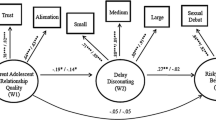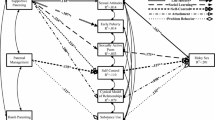Abstract
Purpose
Parent–child relationship quality is an important factor when examining adolescent’s risk for problem behaviors. For this reason, many researchers have explored the impacts of parent–child relationship quality on adolescent and child behavior, yet the parent–child relationship has lasting consequences into adulthood.
Methods
The current study examined the mediating role of risky sexual behavior (as measured by the Youth Risk Behavior Survey) on the relationship between parent–child relationship quality (as measured by the Parental Environment Questionnaire) and quality of life (as measured by the World Health Organizations Quality of Life Questionnaire) beyond adolescence, during emerging adulthood. The additional moderating effects of gender were examined. Participants consisted of 507 undergraduate students (173 males, 334 females) recruited from a large university in the Southern United States between 18 and 25 years of age.
Results
Parent–child relationship quality was positively related to quality of life among both males and females. The indirect pathway from parent–child relationship quality to quality of life, through risky sexual behavior, was significant in females but not in males.
Conclusions
Results suggest that the parent–child relationship, specifically for females, may be a target for intervention in the prevention of risky sexual behavior in Emerging Adulthood. Further results, implications, and limitations were discussed.

Similar content being viewed by others
References
Adeyemo, D. A., & Williams, T. M. (2009). Some correlates of risky sexual behavior among secondary school adolescents in Ogun state, Nigeria. Child & Youth Services, 31(1–2), 53–69. https://doi.org/10.1080/01459350903505587.
Arnett, J. J. (2000). Emerging adulthood: A theory of development from the late teens through the twenties. American Psychologist, 55, 469–480. https://doi.org/10.1037/0003-066X.55.5.469.
Babore, A., Trumello, C., Candelori, C., Paciello, M., & Cerniglia, L. (2016). Depressive symptoms, self-esteem and perceived parent–child relationship in early adolescence. Frontiers in Psychology, 7, 982
Bachanas, P. J., Morris, M. K., Lewis-Gess, J. K., Sarett-Cuasay, E. J., Flores, A. L., Sirl, K. S., & Sawyer, M. K. (2002). Psychological adjustment, substance use, HIV knowledge, and risky sexual behavior in at-risk minority females: Developmental differences during adolescence. Journal of Pediatric Psychology, 27(4), 373–384.
Baril, M. E., Crouter, A. C., & McHale, S. M. (2007). Processes linking adolescent well-being, marital love, and coparenting. Journal of Family Psychology, 21(4), 645–654. https://doi.org/10.1037/0893-3200.21.4.645.
Barry, B., & Stewart, G. L. (1997). Composition, process, and performance in self-managed groups: The role of personality. Journal of Applied Psychology, 82, 62–78.
Baumeister, R. F., & Leary, M. R. (1995). The need to belong: Desire for interpersonal attachments as a fundamental human motivation. Psychological Bulletin, 117(3), 497–529.
Byrne, B. M. (2016). Structural equation modeling with amos (3rd ed., pp. 94–99). New York, NY: Routledge.
Campbell, C. A. (1995). Male gender roles and sexuality: Implications for women’s AIDS risk and prevention. Social Science & Medicine, 41(2), 197–210.
Carlo, G., McGinley, M., Hayes, R., Batenhorst, C., & Wilkinson, J. (2007). Parenting styles or practices? Parenting, sympathy, and prosocial behaviors among adolescents. The Journal of Genetic Psychology, 168(2), 147–176.
CDC. (2011). 2011 National Youth Risk Behavior Survey. Retrieved September 4, 2011, from the Centers for Disease Control and Prevention Youth Risk Behavior Surveillance website http://www.cdc.gov/healthyyouth/yrbs/questionnaire_rationale.html.
Chan, S. M., & Chan, K. W. (2013). Adolescents’ susceptibility to peer pressure: Relations to parent–adolescent relationship and adolescents’ emotional autonomy from parents. Youth & Society, 45(2), 286–302. https://doi.org/10.1177/0044118X11417733.
Chen, A., & Thompson, E. (2007). Preventing adolescent risky sexual behavior: Parents matter! Journal for Specialists in Pediatric Nursing, 12(2), 119–122. https://doi.org/10.1111/j.1744-6155.2007.00101.x.
Crawford, M., & Popp, D. (2003). Sexual double standards: A review and methodological critique of two decades of research. Journal of Sex Research, 40(1), 13–26.
DelPriore, D. J., Schlomer, G. L., & Ellis, B. J. (2017). Impact of fathers on parental monitoring of daughters and their affiliation with sexually promiscuous peers: A genetically and environmentally controlled sibling study. Developmental Psychology, 53(7), 1330–1343. https://doi.org/10.1037/dev0000327.
Dimbuene, Z. T., & Defo, B. K. (2011). Risky sexual behaviour among unmarried young people in Cameroon: Another look at family environment. Journal of Biosocial Science, 43(2), 129–153. https://doi.org/10.1017/S0021932010000635.
Downing-Matibag, T., & Geisinger, B. (2009). Hooking up and sexual risk taking among college students: A health belief model perspective. Qualitative Health Research, 19(9), 1196–1209. https://doi.org/10.1177/1049732309344206.
Elkins, I. J., McGue, M., & Iacono, W. G. (1997). Genetic and environmental influences on parent–son relationships: Evidence for increasing genetic influence during adolescence. Developmental Psychology, 33, 351–363.
Estrada, P., Arsenio, W. F., Hess, R. D., & Holloway, S. D. (1987). Affective quality of the mother–child relationship: Longitudinal consequences for children’s school-relevant cognitive functioning. Developmental Psychology, 23(2), 210–215. https://doi.org/10.1037/0012-1649.23.2.210.
Faul, F., Erdfelder, E., Lang, A. G., & Buchner, A. (2007). G*Power 3: A flexible statistical power analysis program for the social, behavioral, and biomedical sciences. Behavior Research Methods, 39, 175–191.
Fosco, G. M., Stormshak, E. a., Dishion, T. J., & Winter, C. (2012). Family relationships and parental monitoring during middle school as predictors of early adolescent problem behavior. Journal of Clinical Child and Adolescent Psychology, 41(2), 202–213. https://doi.org/10.1080/15374416.2012.651989.
Gupta, G. R. (2000). Gender, sexuality, and HIV/AIDS: The what, the why, and the how. Canadian HIV/AIDS Policy & Law Review, 5(4), 86–93.
Hayes, A. F. (2009). Beyond Baron and Kenny: Statistical mediation analysis in the new millennium. Communication Monographs, 76, 879–892.
Kan, M., Cheng, Y., Landale, N., & McHale, S. (2010). Longitudinal predictors of change in number of sexual partners across adolescence and early adulthood. Journal of Adolescent Health, 46, 25–31. https://doi.org/10.1016/j.jadohealth.2009.05.002.
Kline, R. B. (2015). Principles and practice of structural equation modeling (4th ed.). New York, NY: The Guilford Press.
Kogan, S. M., Cho, J., Allen, K., Lei, M.-K., Beach, S. R. H., Gibbons, F. X., … Brody, G. H. (2013). Avoiding adolescent pregnancy: A longitudinal analysis of African-American youth. Journal of Adolescent Health, 53(1), 14–20. https://doi.org/10.1016/j.jadohealth.2013.01.024.
Lohman, B.J. & Billings, A. (2008) Protective and risk factors associated with adolescent boy’s early sexual debut and risky sexual behaviors. Journal of Youth Adolescence, 37, 723. https://doi.org/10.1007/s10964-008-9283-x
Lippold, M. A., Davis, K. D., Lawson, K. M., & McHale, S. M. (2016). Day-to-day consistency in positive parent–child interactions and youth well-being. Journal of Child and Family Studies, 25(12), 3584–3592. https://doi.org/10.1007/s10826-016-0502-x.
Pittman, J. F., Kerpelman, J. L., Soto, J. B., & Adler-Baeder, F. (2012). Identity exploration in the dating domain: The role of attachment dimensions and parenting practices. Journal of Adolescence. https://doi.org/10.1016/j.adolescence.2012.04.006.
Schooler, D., Ward, L. M., Merriwether, A., & Caruthers, A. S. (2005). Cycles of shame: Menstrual shame, body shame, and sexual decision-making. Journal of Sex Research, 42(4), 324–334. https://doi.org/10.1080/00224490509552288.
Shek, D. T. L., & Liang, L. Y. (2017). Psychosocial factors influencing individual well-being in Chinese adolescents in Hong Kong: A six-year longitudinal study. Applied Research in Quality of Life. https://doi.org/10.1007/s11482-017-9545-4.
Shneyderman, Y., & Schwartz, S. J. (2012). Contextual and intrapersonal predictors of adolescent risky sexual behavior and outcomes. Health Education & Behavior, 40(4), 400–414. https://doi.org/10.1177/1090198112447800.
Spitalnick, J. S., DiClemente, R. J., Wingood, G. M., Crosby, R. A., Milhausen, R. R., Sales, J. M., … Younge, S. N. (2007). Brief report: Sexual sensation seeking and its relationship to risky sexual behaviour among African-American adolescent females. Journal of Adolescence, 30(1), 165–173.
Topolski, T. D., Patrick, D. L., Edwards, T. C., Huebner, C. E., Connell, F. A., & Mount, K. K. (2001). Quality of life and health-risk behaviors among adolescents. Journal of Adolescent Health, 29(6), 426–435.
Voisin, D. R., Harty, J., Kim, D. H., Elsaesser, C., & Takahashi, L. M. (2017). Assessing the relationship between parental influences and wellbeing among low income African American adolescents in Chicago. Child & Youth Care Forum, 46(2), 223–242. https://doi.org/10.1007/s10566-016-9373-y.
WHOQOL Group. (1998). Development of the World Health Organization WHOQOL-BREF quality of life assessment. Psychological Medicine, 28, 551–558.
Yucel, D., & Yuan, A. S. V. (2016). Parents, siblings, or friends? Exploring life satisfaction among early adolescents. Applied Research in Quality of Life, 11(4), 1399–1423. https://doi.org/10.1007/s11482-015-9444-5.
Author information
Authors and Affiliations
Corresponding author
Rights and permissions
About this article
Cite this article
Szkody, E., Rogers, M.M. & McKinney, C. Risky sexual behavior: the indirect effects between parent–child relationship quality and quality of life in emerging adults. Qual Life Res 27, 2639–2645 (2018). https://doi.org/10.1007/s11136-018-1919-z
Accepted:
Published:
Issue Date:
DOI: https://doi.org/10.1007/s11136-018-1919-z




